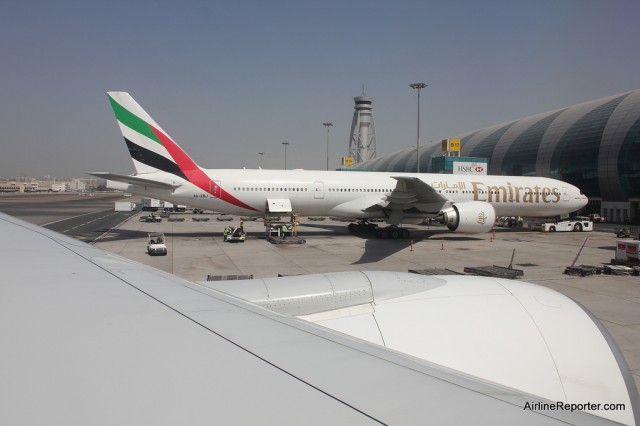
I couldn't get any good shots of my 777-200LR in Seattle or Dubai, so I am using this photo of another Emirates Boeing 777-300ER that I took from my aircraft.
EMIRATES AIRLINE REVIEW BASICS:
Airline: Emirates Airline
Aircraft: Boeing 777-200LR
Departed: Seattle-Tacoma International Airport (SEA)
Arrived: Dubai International Airport (DXB)
tops: Non-stop flight Class: Business Class
Seat: 8D to DXB (center, aisle, bulkhead) and 11A to SEA (window)
Length: About 14 hours
Cheers: Great combination of service and product.
Jeers: If you have wide shoulders, avoid the center seat — even in business class.
Overall: Emirates makes a 14 hour flight easy.
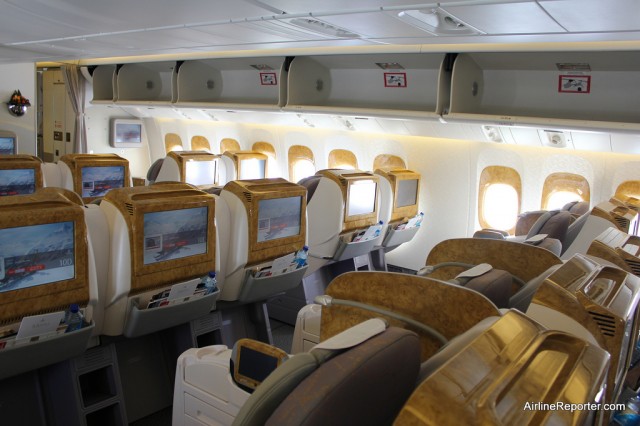
With the wood paneling, the Business Class really has a warm atmosphere. Notice the real flowers on the bulkhead.
THE FULL EMIRATES BUSINESS CLASS REVIEW:
On March 1st, Emirates started flying from Seattle to Dubai non-stop. I was invited to try out Emirates Business Class product on one of their recent flights (the airline covered the costs of the flight). This review will be a mixture of both my flight to and from Dubai — although I slept most of the way home.
The benefits of sitting in a premium cabin starts well before you get to the gate, but only once you arrive to the airport. With Emirates, the benefits of flying in Business Class starts at home. If you fly in either Business or First class you have access to a free chauffeured car within 60 miles of your arriving or departing airport. Unfortunately I did not do my homework before leaving and did not find out about that service until I was in Dubai (thanks Ben for the ride to the airport by the way).
However, I was able to make use of the service when coming home and it is always great having someone greeting you with your name on a sign that escorts you right to your front door in a Town Car. Having a Business Class ticket normally gives you access to a lounge at the airport and flying Emirates out of Seattle is no different. Passengers who have either first or business class tickets are able to use the new Club International lounge before their flight.
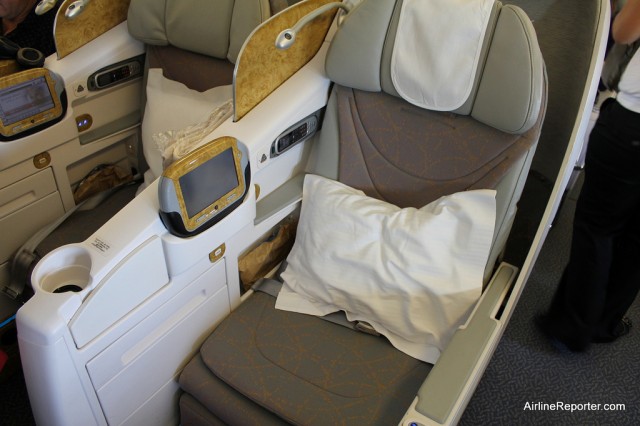
Emirate's Business Class seats offer quite a bit of room and one ginormous remote.
Since I stayed in the lounge for a while, my flight was almost fully loaded by the time I arrived at the gate and I was able to just walk on the plane. I messed up and forgot to check myself in online (I know, what kind of airline reporter am I?), so I ended up in a middle seat: 8E. Emirates has their 777-200LR configured in a 2-3-2 layout in business.
Even though the seats are larger, I was not looking forward to being in the center for 14 hours, but at least I wasn’t in economy. When I found my seat and sat down, I became a little worried — my shoulders touched both sides of the hard plastic walls — not good. Luckily for me the lovely (and smaller) Harriet Baskas, who was in my media travel group, had the aisle seat next to me and offered to swap. I gladly took her up on her offer and never had any problems with the seat width with the open aisle.
I think I would have managed just fine in the center seat, but if you have wider shoulders, I would surely advice checking in earlier to claim a non-center seat.
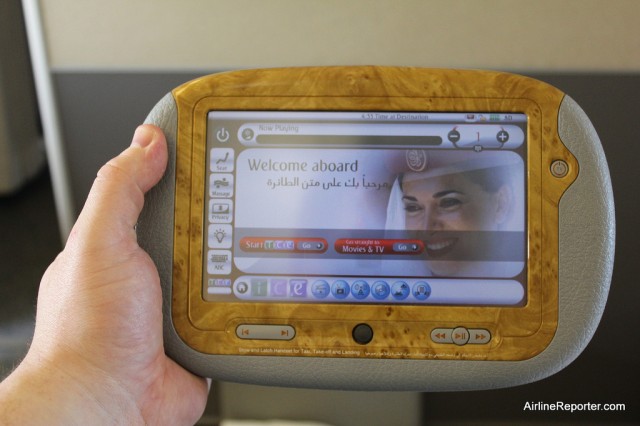
If you like technology and gadgets, you will love Emirates ice entertainment system. Each seat in first and business gets this large, removable remote.
Emirates entertainment system, called ice, was amazing, but a bit overwhelming. First off, you have three options on how to control the system: touching the screen, using the removable touch screen remote or use the smaller wired remote. When sitting in a bulkhead seat, even at 6’1″, I was unable to touch the screen. When I flew back to Seattle I was not at the bulkhead and was able to touch, but it wasn’t easy and I would imagine near impossible if you measuring in at less than 5’10”.
I am normally not very slow when it comes to technology or in-flight entertainment systems, but it seemed like I could only do some things with one remote and I had to do other things with the smaller one. I am sure I just wasn’t able to figure it out, but if I had trouble, I am sure most other people did too. It is worth trying to get past the control issues, because once you do, there are many options — 1200 to be exact.
Emirates, by far, has the largest selection of movies and entertainment I have experienced. After flying a total of 27 hours to Dubai and back, I still had not explored everything it had to offer. For a frequent flier on the airline, this would be a huge perk. No matter what class you are flying in, you get access to the same ice entertainment system (just not the fancy large remote if you are in economy).
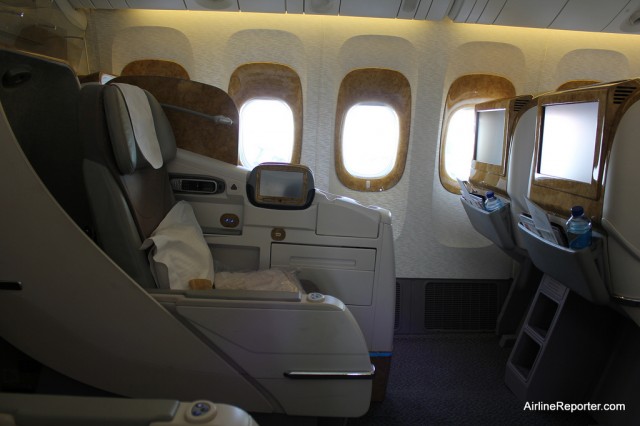
Emirates configures their Boeing 777s with a 2-3-2 layout in Business Class. Notice how the windows have buttons to move the shades.
One on my favorite things, on systems that offer it, are the outside cameras you can access on your screen. The Emirates 777 has one facing forward and once facing straight down. Being in the center section during take off, it was handy watching the aircraft take off via the cameras. We took off to the north and just kept going — almost in a straight line over the north pole and back down to Dubai. Because of this, it never got dark outside.
Passengers also have the option to make a phone call at $5 per minute or send text messages for $1 per message. Every time I tried to access the service, it said it was unavailable, which was okay by me. I was planning on trying it out for the story, but was not motivated to ask one of the flight attendants, since I did not mind saving my money. Although Emirates does have Wi-Fi up and running on all their Airbus A380s, they do not have it on the rest of their main fleet (777, A330, A340) — yet.
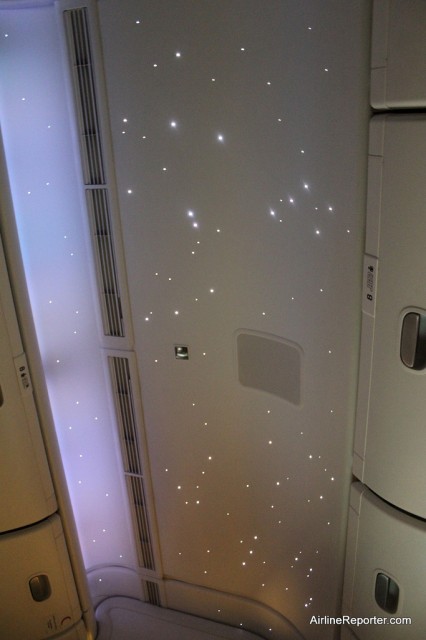
When the lights go down, the stars come up. Emirates offers a special StarLight feature providing a great sleeping atmosphere.
The new Boeing 787 Dreamliner is touted as being unique for its ambient lighting and electronic sunshades. The Emirates product in business and in first is almost as close as you can get to the 787 interior.
First, they have the ambient lighting; going from a soft white/yellow to pinks to purple for the different light cycles. Then you have the windows up front that do not have manual shades, but two buttons that make the shades go up and down. The flight attendants have the ability to to put up or down all the shades, similar to the 787.
What Emirate’s 777 has that no 787 has (yet) are the stars that come out on the ceiling. Called StarLight, this amazing feature is unique to Emirates and really sets the mood. It is hard to describe, laying flat on a bed at 35,000 feet, opening your eyes and seeing stars.
It is too bad that Emirates doesn’t have any 787’s on order; it would be amazing what they could (and probably would) do with that cabin.
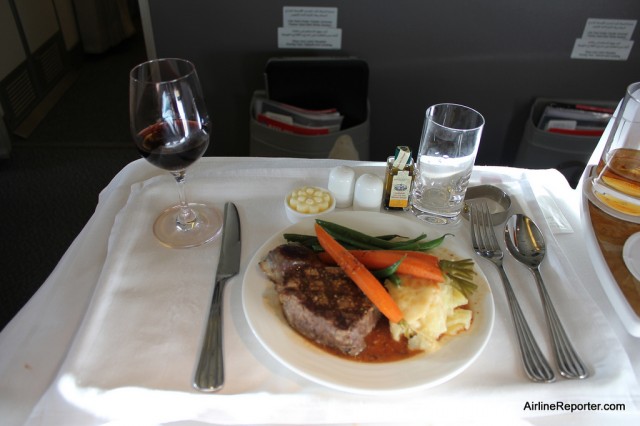
Steak, potatoes I cannot pronounce and red wine at 30,000 feet? Yea, I can handle that.
After settling in, it was time for meal service. My dinner started with a traditional mezze platter with hummus, smoky moutabal, muhammara, vine leaves and a spinach fatayer. Yea, I don’t know what half of that means either, but I can tell you that it was great. Then I was served roasted tomato and thyme soup and salad, followed by the main course of beef fillet with shallots and dauphionouse style potatoes. I decided to skip the dessert option and have a bit more red wine — nice call.
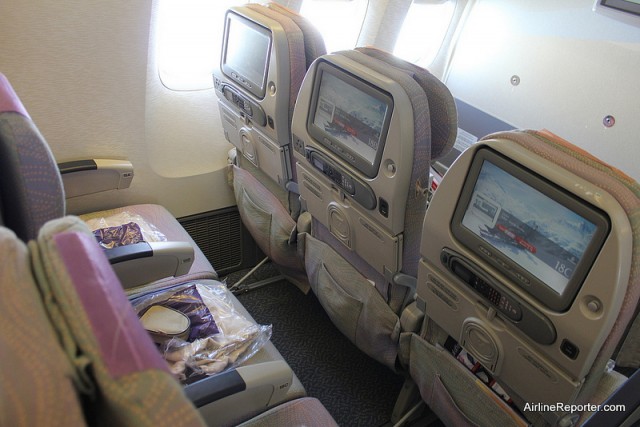
Economy class still provides large screens, amenities and food. Eh, I will stick to Business Class.
I feel very lucky that I get these opportunities to fly in the front of the plane on long flights, but there is no doubt that I have put my time in economy. During the ride over to Dubai, I made an effort to make a lap around the plane and check out economy. During my tour, most people were sleeping and there were so many feet, arms, shoulders, etc out in the aisle — it was a challenge to get through without bumping into people.
With the 3-4-3 layout in economy, it is a bit tight, but doable with the large screens and same ice entertainment system. That being said, I was happy to return to the business class cabin.
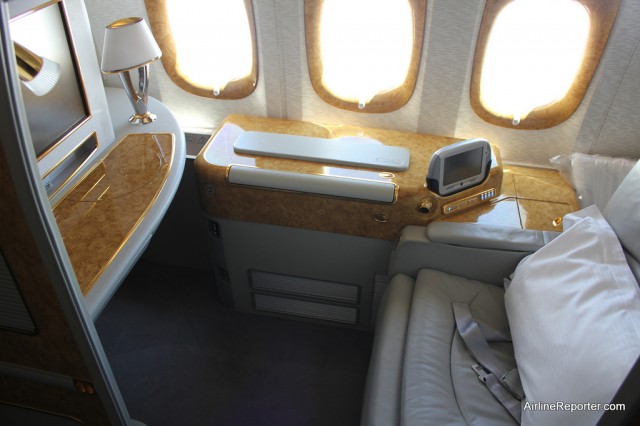
Business Class is nice, but First Class is better. Each seat is like its own cubicle, with closing doors.
When I complete flight reviews, I try to stay anonymous as long as I can. Typically a flight attendant will start asking questions (not suspiciously, but out of curiosity) when I am taking photos of my remote, food, etc. One of the benefits of being known as media is getting access to the aircraft that others might not.
On the flight back to Seattle, I was given the opportunity to spend some time up in First Class. Luckily for me, there were no passengers in the front cabin, which gave me time to check it out and talk to the flight crew. There are four crew members assigned to first class, including the pursuer. They normally work in shifts of two, but when there are no passengers in first, they are able to enjoy a relaxing flight and also will help the rest of the cabin crew, if needed.
Where business felt so much better than economy, similarly first class felt so much better than business. There are only eight first class suites, where each has a large seat, own mini-bar, large tv screen, similar controls to business class and doors that can be closed to give ultimate privacy.
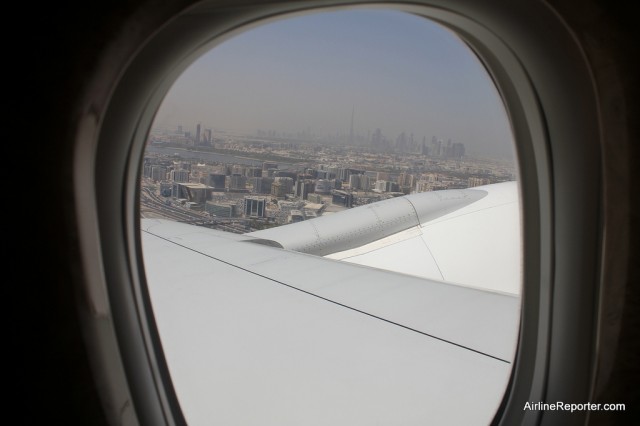
Taking off from Dubai I could see the world's tallest building, the Burj Khalifa in the background.
One indicator on how good a product is on an airline is how well I am able to sleep. The fact that I slept five hours to Dubai and about 10 hours back to Seattle is a positive sign for sure. Another indicator is how happy I am that I was able to sleep so much. In this case, I was upset that I slept so much and wasn’t able to enjoy my experience a bit better. Emirates has lived up to its reputation for providing a fabulous flying experience.
Next is to try and test out their newer business product on the Airbus A380 — stay tuned.
See all 52 photos from my Emirates Airline flight
MORE STORIES ON MY DUBAI TRIP:
* Photo Tour of Emirates Airline Crew Training in Dubai
* Airline Lounge Review: Club International at Sea-Tac Airport
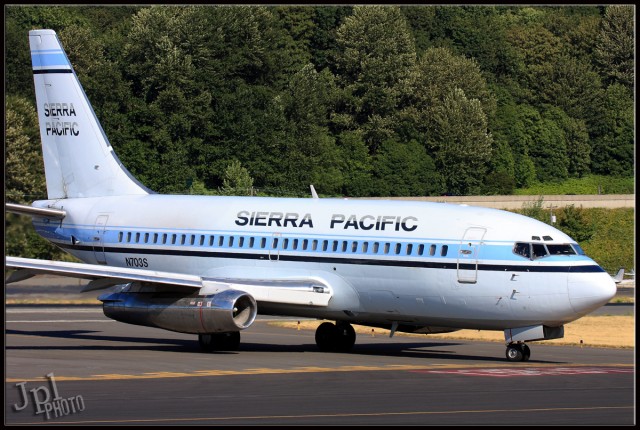
Sierra Pacific Airlines Boeing 737-200 taken at Boeing Field (BFI). Photo by Jeremy Dwyer-Lindgren.
I am always game for an airline in the US operating with a few classic Boeing 737-200s. It is rare to find one still operating in the US and soon, it will surely be impossible.
Sierra Pacific Airlines was founded in 1971 and currently operates two 737-200s (N703S and N712S) out of their base in Tucson, AZ. The airline runs charters and sub-charters for other airlines, while also running flights for the US Forest Service, US Military and the US Marshals.
Like most classic airliners, comes a classic livery and Sierra Pacific is no different. The livery rocks that cheat-line that is not seen on many of today’s modern jets.
Seeing this livery next to others a bit more modern, it comes up a bit short. Yet seeing it as an historical package, how can one not like it?
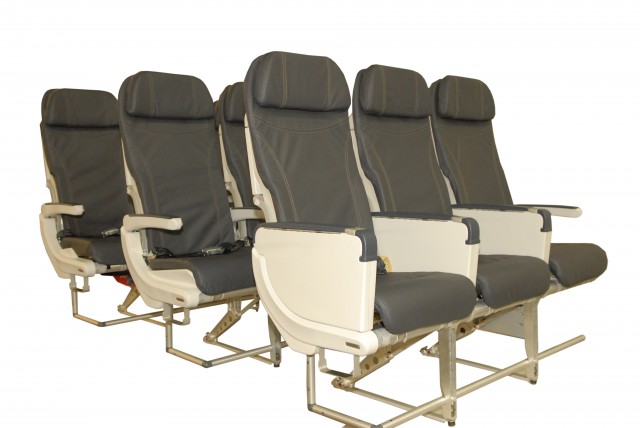
Alaska Airlines new New Recaro seats for economy class that will make their appearance on the airline's new Boeing 737-900ERs. Image from Alaska.
Alaska Airlines has announced that they will be installing new seats from Recaro Aircraft Seating on their 22, soon-to-be delivered, Boeing 737-900ERs.
The seats will offer a six-way adjustable headrest, three inches of recline and an additional inch of legroom.
The additional leg room will not affect the airline’s seat pitch of 31-32″, but it will offer more room for your legs. “The extra inch we refer to is gained by Recaro’s clever design that effectively adds one more inch of room to your living space, without us moving the seats further apart,” Alaska spokes person confirmed to AirlineReporter.com. “Specific to pitch, our pitch will stay consistent with our current standard 31-32 inches.”
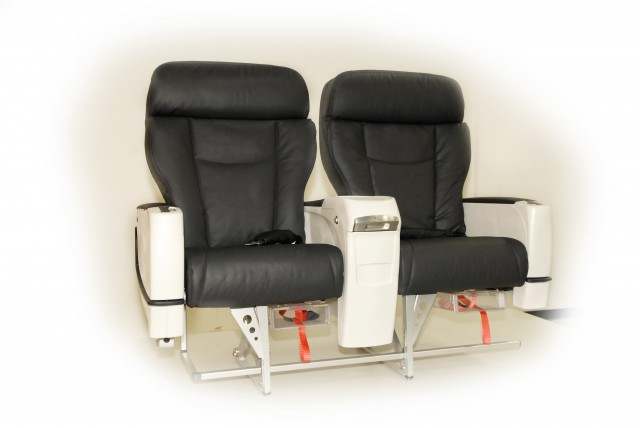
Alaska Airlines new New Recaro seats for First Class that will make their appearance on the airline's new Boeing 737-900ERs. Image from Alaska.
Alaska will also get new Recaro seats for the first class cabin that will offer five inches of recline, an articulating seat bottom and a six-way adjustable headrest.
The seat, “design includes a comfortable yet slimmer seatback and bottom and a literature pocket located above the tray table,” said Joe Sprague, Alaska Airlines’ vice president of marketing. “The new seats add to a very special onboard experience that all of our customers flying Alaska’s new 737-900ERs will enjoy, including Boeing’s Sky Interiorwith its improved lighting and sculpted overhead bins that create a more spacious cabinonboard Wi-Fi, Starbucks coffee, premium Washington wines and delicious meals for purchase, as well as our renowned personal service.”
The seats are also lighter and are expected to save about 8,000 gallons of fuel annually per aircraft.

Allegiant MD-80 and Spirit Airbus A319 hanging out in Las Vegas. Photo by Joe (JX).
With Spirit Airlines raising their carry-on fee at the gate to $100 ($35 if you pay ahead of time after November 6th) and Allegiant Air starting to charge for their carry-ons, it has a bunch of people very upset. But why? If an airline comes out with a policy you do not agree on, do not fly them. They will get the message and either change their policies or go out of business. Even though people state they won’t fly either airline, both Allegiant and Spirit continue to grow, so why would they want to reverse their fees?
Yes, I realize that some passengers do not have many choices at their closest airport. However, there is a reason why other airlines are not able or willing to fly into those airports — they can’t make it profitable. So, you are either stuck with an airline that charges fees, one that runs turbo-props or you take the bus.
What interests me are the people that do have a choice, complain about fees, yet continually choose either of the two ultra low-cost carriers.
Being human, most people want their cake and eat it too. Passengers want a first class experience at an ultra low-cost carrier price. Sorry to break it to you — that is not going to happen.
When asked how Spirit Airlines views its fees, Misty Pinson, Director of Spirit Communications, told AirlineReporter.com, “Our ultra low fares with optional add-ons are very consumer friendly. We give customers the opportunity to save money with our low fares and give them the power to choose the extras they want, and they only pay for those they use rather than being forced into paying a higher fare that includes extras that they don’t even want or use.”
Some of you might be rolling your eyes thinking that Spirit is just spinning the fees as a good thing, but Pinson actually gives some good points. If I fly on another airline that might not have as many fees, but I don’t want a soda, I don’t have a bag to check and I am not interested in food, I am still paying for all of those things in my ticket price. Yet airlines, like Spirit, give you the option to pay less overall, if you are not going to use all the options. How is that unfair? Especially when you do all all the fees to the base fare, the overall price still comes under most other airlines.
I also reached out to Allegiant to check in on charging for carry-on bags is going. “Inevitably, when you start to charge for something that used to be free, there will be some people who are vocal about it, but ultimately, we have seen that only about a third of our customers are purchasing overhead bin space when they make their travel reservations online,” Allegiant spokesperson explained over email. “As we unbundle our product and drive down base fares, we are able to stimulate demand and see growth in the number of people who can afford to travel.”
Let’s take a closer look at how both airlines have been doing; comparing the first quarter of 2011 to 2012, both airlines did very well (all data from SEC):
ALLEGIANT
Revenue Passenger Miles (RPM) are up 17.2%
Passenger revenue is up 25.8%
Average fare is up 6.7% to $94.95
Average fare (ancillary revenue) is up 4.2% to $37.75
SPIRIT
RPMs are up 18.8%
Passenger revenue is up 17.5%
Average fare per passenger flight segment is down 6.9% to $76.65
Non-ticket revenue per passenger flight segment is up 21.3% to $51.68
That 6.9% decrease is important to note. It indicates that the people who don’t buy anything else are getting a better deal on Spirit flights.
If you were an airline and wanted to make profit (when it comes down to it, that is what every airline wants right?) and you have this business model that makes you profit, while you continue to grow your passenger load, why wouldn’t you do it? There is obviously enough demand for airlines like Allegiant and Spirit to exist with other domestic carriers Southwest, Alaska and Virgin America as well.
Many feel that ultra low-cost carriers have started a race to the bottom for overall experience. I disagree. They have provided a cheaper option for people who care more about getting from point A to point B as cheaply as possible than they do about amenities. If you want to ride in style, you can still pay more to fly in first class on another airline, not have to pay any fees, get more room and even a meal. The “golden-age” style of flying still exists, but it will just cost you much more (like it did in the “good ol days”).
If you are still angry about all those airline fees, it is okay to be angry — just don’t blame the airlines. If you are going to blame anyone, blame those passengers who see them as a better overall deal and create the demand for airlines like Allegiant and Spirit to come along and fill.
Alright, let’s hear it… what do you think of these new/higher airline fees?
A huge thanks to Dan Webb for helping me with these numbers and to Joe (JX) for letting me use his photo.
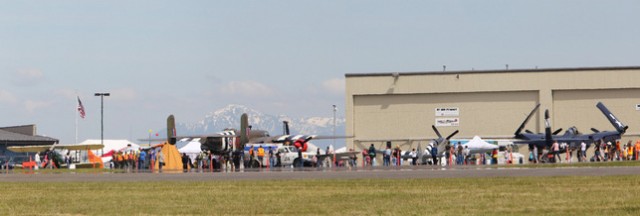
A view of General Aviation Day (now Paine Field Aviation Day) in 2010. Image by Liz Matzelle.
On Saturday, May 19th from 9:00am to 5:00pm, Snohomish County Airport (Paine Field – KPAE) and the Washington Pilots Association ’“ Paine Field Chapter will present Paine Field Aviation Day and you should come.
Admission will be $5 per person or $10 for the entire family. Admission also includes free access to the Flying Heritage Collection and the Historic Flight Foundation. Parking is free and there will be shuttles running from three designated lots throughout the day. The shuttles will drop guests off at the FHC or HFF and there will also be shuttles inside the airport to take guests from one side of the event to the other.
This will be the 17th year that the event is held and provides a bunch of activities:
* FREE YOUNG EAGLES FLIGHTS (KIDS 8-17)
* FIRE FIGHTERS FLY DAY 5K AND PANCAKE BREAKFAST ($5/person ’¢ 9:00am to 11:00am ’¢ benefiting the Northwest Burn Foundation)
* STATIC AIRCRAFT DISPLAYS
* SCENIC HELICOPTER & BIPLANE FLIGHTS (additional cost)
* GREAT FOOD, VENDORS AND KIDS ACTIVITIES
* AVGEEKS FROM AROUND THE GREATER SEATTLE AREA
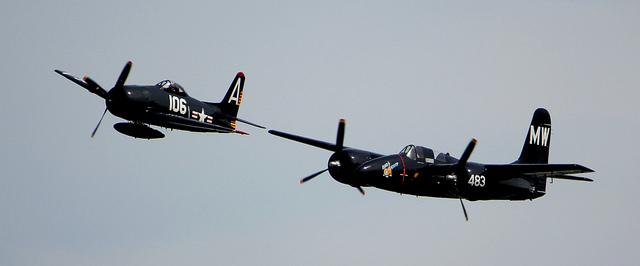
Not all the planes just sit on the ground. F7F Tigercat and F8F Bearcat in formation. Photo by Liz Matzelle.
From the WPA’s press release, “Come see the latest in general aviation aircraft as well as many of the airplanes owned and operated by local private pilots. Vintage aircraft and warbirds will be on display thanks to the participation of the Museum of Flight Restoration Center, Flying Heritage Collection, Historic Flight Foundation and Cascade Warbirds. Among these will be WWII aircraft and many pre-war military and civilian aircraft. Also, in conjunction with the 70th Anniversary of the Doolittle Raid, there will be up to 5 vintage B-25 aircraft on
display. Along with these fascinating and historic aircraft, there will be automobile displays, unlimited hydroplane displays, and some of Paine Field’s fire apparatus will also be on hand for kids to get an upclose look. Beginning at 12:00 pm, the warbirds will take flight, as well as formation flying by The Blackjack Squadron, the Cascade Warbirds and other aviation groups.”
SEE THE OFFICIAL FLYER















